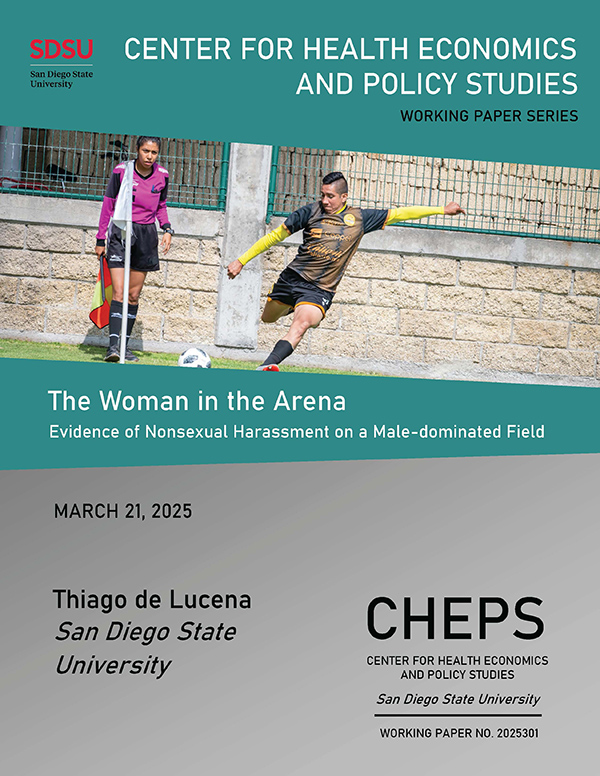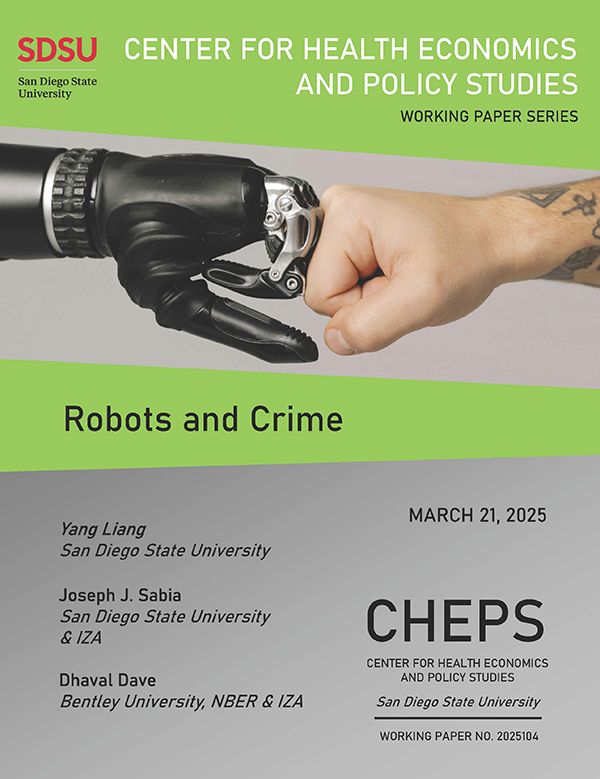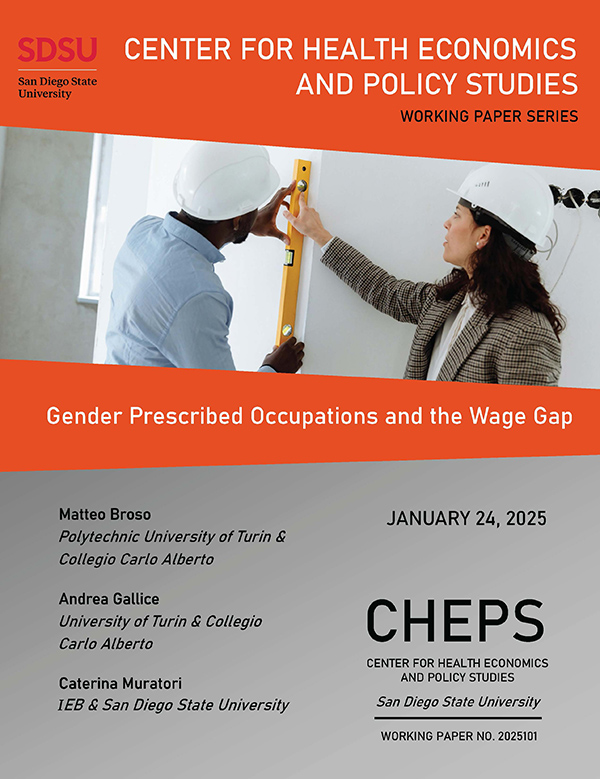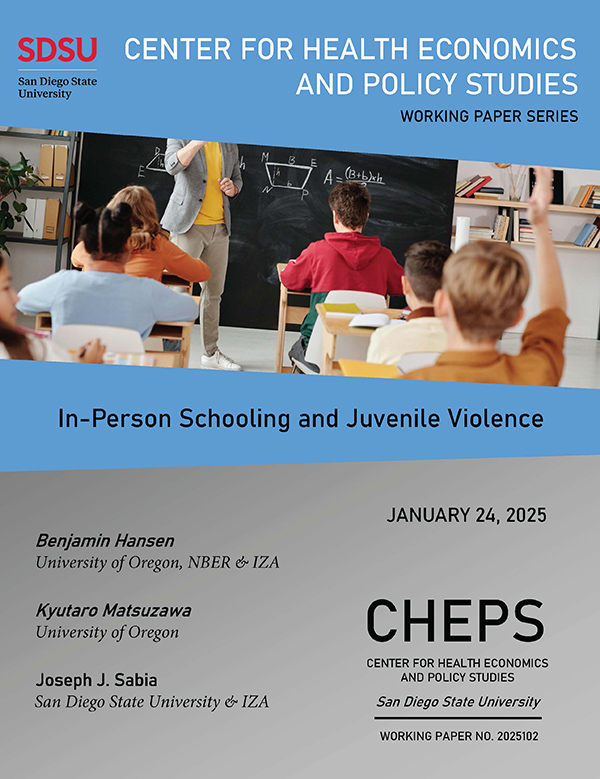
Welcome from the Director
 The Center for Health Economics & Policy Studies (CHEPS) is an interdisciplinary research
center that supports impactful, policy relevant scholarship in the areas of health
economics and social policy analysis. Housed in the College of Arts & Letters, CHEPS
brings together faculty and graduate students engaged in complementary research in
the areas of national defense policy, economic demography, the economics of crime
and punishment, and the economics of risky health behaviors. Read more>>
The Center for Health Economics & Policy Studies (CHEPS) is an interdisciplinary research
center that supports impactful, policy relevant scholarship in the areas of health
economics and social policy analysis. Housed in the College of Arts & Letters, CHEPS
brings together faculty and graduate students engaged in complementary research in
the areas of national defense policy, economic demography, the economics of crime
and punishment, and the economics of risky health behaviors. Read more>>
Read the CHEPS Magazine 2024
Past issues of the magazine: 2023 | 2022 | 2021 | 2020 | 2019 | 2018
CHEPS Pioneering Research
Featured Research
 Flavored E-Cigarettes and Teen Vaping
Flavored E-Cigarettes and Teen Vaping
Electronic nicotine delivery systems (ENDS) are devices in which nicotine and other ingredients, such as flavors, are heated into a vapor and inhaled. Since 2014, electronic cigarettes (e-cigarettes) have surpassed combustible tobacco products as the most commonly used tobacco product among youths in the United States. Tobacco control advocates consistently point to the availability of flavored e-cigarettes as attracting youths to nicotine vaping.
E-cigarettes may come in various flavors, including fruit, candy, mint, and menthol, many of which are popular among teenagers. According to the 2023 National Youth Tobacco Survey, 89 percent of youths who reported that they currently vaped nicotine reported using flavored varieties. Among the most common flavors vaped were fruit (63 percent), candy, desserts, or other sweets (35 percent), mint (28 percent), and menthol (20 percent). The impact of restricting access to flavored ENDS on youth and young adult nicotine vaping is still a matter of conjecture. More than three-quarters of youths and young adults who vape nicotine state they would cease using these products if they were not flavored. However, their revealed behavior is, as yet, untested. This study, co-authored by Chad Cotti, Chuck Courtemanche, Yang Liang, Catherine Maclean, Erik Nesson, and Joe Sabia, is among the first to explore the impact of ENDS flavor restrictions on youth and young adult ENDS use. This study explores the effects of ENDS flavor restriction policies on youth and young adult ENDS and combustible tobacco product use. Preliminary findings show that while some flavor restrictions may have their intended effects — that is, reducing ENDS use among some youths — there is also evidence of unintended spillover effects of these laws, causing some teens to substitute e-cigarettes with combustible tobacco products. This study was supported by a grant from Global Action to End Smoking (formerly known as the Foundation for a Smoke-Free World). Exploratory research on this project was supported by the National Institutes of Health.
Do E-Cigarette Retail Licensure Laws Work?
E-cigarette licensure laws (ELLs) require sellers to obtain a state license to sell e-cigarettes over the counter and often impose penalties and fines up to $25,000 for violations. These laws are designed to regulate sales, increase compliance with state tobacco regulations, and reduce the supply of e-cigarettes available to consumers, in particular youth.
There are several pathways through which ELL adoption could affect youth ENDS use. First, compliance with ELLs (through fear of fines, penalties, and loss of the license, and information flows from meeting with regulators during compliance checks) may result in stricter enforcement of e-cigarette sales regulations — including MLPAs — which could reduce youths’ access to e-cigarettes.
Additionally, ELLs may impose additional compliance (financial) costs on sellers of e-cigarettes and retailers may pass along these costs to consumers in the form of higher prices, thereby reducing sales. Youths may be particularly affected given that they are, on average, more income constrained than adults. Relatedly, licensure requirements may induce sellers to avoid selling e-cigarettes altogether, which may (1) increase local e-cigarette prices through a negative supply shock or (2) increase time and travel costs to alternative vendors to obtain e-cigarettes.
On the other hand, if the costs of obtaining a license are relatively low or if the ELL does not promote better enforcement of e-cigarette law provisions such as the MLPA, ELL adoption may have little effect on market prices of or local access to e-cigarettes, resulting in a trivial impact on youth consumption Moreover, if informal social markets (e.g., friends to whom youths can turn to borrow or bum e-cigarettes) or online markets insulate youths from the effects of local ENDS regulations such as ELLs, then ELLs may have little effect on youth ENDS use.
A new NBER Working Paper by Chuck Courtemanche, Catherine Maclean, Yang Liang, Caterina Muratori, and Joe Sabia is among the first to comprehensively examine the effects of ELL adoption on youth and adult tobacco use. Preliminary evidence suggests that while ELLs are ineffective at curbing ENDS use for the average teenager, there is some evidence that e-cigarette use among Black teens may decline in response to the adoption of ELLs that are accompanied by relatively higher penalties for non-compliance with the law.
This study was supported by grants from the National Institutes of Health (via a subcontract from Georgia State University) and Global Action to End Smoking.
Anti-Vaping Laws and Disparities in Tobacco Use
Lesbian, gay, bisexual, and questioning (LGBQ) teenagers face unique psychological challenges. Religious critiques of homosexuality, societal discrimination, and family conflict surrounding sexual identity generate substantial stress that contribute to sharp disparities in mental health between LGBQ and heterosexual youth. LGBQ teens are more likely to experience depressive symptomology and engage in suicidal behaviors than their heterosexual counterparts. These adverse psychological consequences contribute to higher rates of risky health behaviors for sexual minorities, perhaps as a coping mechanism for psychological trauma.
Tobacco use among LGBQ-identifying teenagers is substantially higher than among heterosexual youth. In 2021, prior-month use of electronic nicotine delivery systems (ENDS) among LGBQ youth was substantially higher (22 percent versus 16 percent) and combustible cigarette use higher (6 percent versus 3 percent) than among heterosexual teens.
These disparities may lead to significant tobacco-related disparities in mortality and morbidity later in life, as tobacco use is the leading cause of preventable death in the United States, carrying with it elevated risks of cancer, heart disease, and respiratory health problems. Over 450,000 individuals die each year from combustible tobacco products.
Successful policy interventions to curb disparities in youth tobacco use, especially of combustible products, could generate disproportionate health benefits for LGBQ individuals. A series of new projects co-authored by Anthony Chuo, Joe Sabia and their new colleagues will examine the effects of anti-vaping policies on disparities in ENDS and combustible tobacco product use among heterosexual- and LGBQ-identifying youths. These
projects will provide new insights into how tobacco-related public health policy can affect relative health risks among vulnerable, historically marginalized populations. These studies are supported by a grant from Global Action to End Smoking (formerly known as the Foundation for a Smoke-Free World) and San Diego State University, including the College of Arts & Letters and the Division for Research and Innovation.
E-Cigarette Taxes and Substance Use
Marijuana is the most commonly used illicit drug, with one in five adults and one in ten youth consuming the product in 2021. At the same time, ENDS use has grown dramatically since the entrance of these products in U.S. tobacco markets in 2006, with 32.1 percent of 12th grade students consuming these products in the past year in 2022.
According to the Centers for Disease Control and Prevention’s latest survey of U.S. high school students, 10.1 percent of teenagers are dual users of ENDS and marijuana. While both products potentially confer health benefits to adults, public health advocates caution that greater access to, and use of, these products can have serious and negative health implications, particularly for youths and young adults.
Despite frequent calls from public health advocates regarding the health harms associated with early initiation of marijuana use and the risks associated with joint use of ENDS and marijuana, no study has comprehensively examined the spillover effects of anti-vaping policies on illicit drug use.
To fill this critical gap in the literature, a new study by Dhaval Dave, Catherine Maclean, Yang Liang, Caterina Muratori, and Joe Sabia (published as a National Bureau of Economic Research Working Paper) provides the first evaluation of raising ENDS taxes, one of the most recent and prominent policies adopted by states and local governments to curb vaping, on marijuana and harder drug consumption among youth and adults.
The authors find robust evidence that a one-dollar increase in the ENDS tax leads to a 5.7 to 13.4 percent decline in marijuana use among youth and a 10.3 percent decline among adults 18 years and older. This result is consistent with the hypothesis that e-cigarettes and marijuana are economic complements.
In addition, we note that our finding that marijuana use declines post-ENDS tax appears to be driven by light or experimental marijuana users, and not heavy consumers, and that ENDS taxes do not result in any change in non-marijuana drug use or drug treatment admissions. Our estimates represent average treatment effects over approximately two (2) years. If so-called gateway effects on harder drugs take longer to unfold, future research will be necessary to detect them.
More Research
Pretextual stops, also known as Terry stops, are a common policing strategy employed to detect crime. This strategy involves stopping a driver for minor infractions, such as broken taillights, to investigate other suspected criminal activity. For instance, a police officer may pull over a driver for a minor infraction and ask the driver, “Do you know why you were pulled over?” The police officer asks this question, hoping the driver admits to a more severe crime.
Although the U.S. Supreme Court ruled these traffic stops constitutional in 1996, many policymakers debate whether police officers should conduct these stops. On one hand, the proponents of pretextual stops argue that such stops are essential to find criminals and reduce criminality effectively. However, the opponents of such stops argue that pretextual stops contribute to racial disparities because police officers may either implicitly or statistically discriminate against racial minorities and may more likely pull these people over for a minor traffic violation. As a result of such debate, many cities and jurisdictions started prohibiting pretextual stops or considering such prohibitions.
On March 1, 2022, the Los Angeles Police Department (LAPD) effectively limited police officers from conducting pretextual stops. This new bill now mandates that police officers stop a driver only when the driver is considered a threat to public safety. According to the new law, when police officers conduct traffic stops, they must verbally explain the reason for pulling over the driver and record their reasoning on their body-worn video cameras. Failure to comply will result in the officer undergoing retraining after the first offense, followed by severe discipline for subsequent violations. Moreover, effective January 1, 2024, a new state Senate bill banned pretextual stops in all of California.
For his job market paper, Kyutaro Matsuzawa will leverage this limitation of pretextual stops to investigate whether pretextual stops are effective in terms of enhancing public safety and to what degree they contribute to police discrimination. He will first estimate using a regression discontinuity in time estimator and difference-in-differences using various counterfactuals to document a first-stage effect that this policy did reduce the use of pretextual stops. Next, he will investigate a second-stage effect following the limitation of pretextual stops. This includes exploring what actions police take as an alternative, assessing changes in police search and hit rates, and evaluating potential changes in public safety, such as traffic accidents or crime rates.
A new study by Postdoctoral Fellow Tessie Krishna investigates whether the diversion of juveniles from formal processing in the criminal justice system leads to lower recidivism rates using Florida’s Juvenile Civil Citation Program. This program, which was rolled out across counties in a staggered fashion, allows law enforcement to divert first-time misdemeanor offenders from the formal juvenile justice system by issuing a Civil Citation (akin to a traffic ticket) instead of arresting them. The program aims to rehabilitate juveniles, keeping their record clear upon successful completion.
Krishna employs a combination of estimation techniques, including standard and dynamic difference-indifferences, ordinary least squares, and instrumental variable estimators. She finds that the Civil Citation Program significantly reduces recidivism among eligible populations, showing a decline of 15-57% over baseline recidivism rates. Juveniles who received citations were between 32-38% less likely to recidivate compared to those who did not. The results suggest that diversion programs like the Civil Citation Program can effectively reduce juvenile delinquency and prevent deeper involvement with the criminal justice system, provided the decline does not stem from net widening (an increase in the number of people coming in contact with the criminal justice system as the unintentional result of a new practice). The investigation of whether the program led to net-widening is currently in progress.
Her paper contributes to the broader literature on the economics of crime and justice reform by quantitatively demonstrating the costs and benefits of diversion programs. It expands on existing studies by using a variety of methodological approaches to address potential biases and varying effects across different contexts. It also suggests areas for future research, particularly in examining long-term outcomes and comparing different types of diversion programs. This research was part of Krishna’s dissertation as a Ph.D. student at Rutgers University.
The prevalence of high-profile shootings in the United States over the past decade has deeply impacted societal consciousness. The escalation of active shooter incidents, resulting in fatalities and injuries, not only imposes direct costs but also triggers widespread fear and behavioral changes. While existing literature explores the indirect costs of mass shootings on various sectors, limited attention has been given to the immediate effects on urban businesses. This paper by Hao Fe aims to fill this gap by examining how mass shootings affect consumer visits and expenditures in nearby establishments.
Utilizing a fine-grained longitudinal dataset spanning major U.S. metropolitan areas, they analyze 130 mass shooting incidents between January 2017 and September 2019. The dataset links shooting events to consumer visits and transaction data for venues in close proximity to the incidents. They employ a nonparametric difference-in-differences method to assess the impact of shootings on foot traffic and transaction values, considering both incidents with clear targets and those without. Additionally, they explore the differential responses in areas with varying minority populations.
Their analysis reveals nuanced patterns in consumer behavior following mass shootings. While overall foot traffic shows minimal fluctuations, incidents without clear targets lead to immediate declines in consumer visits, particularly in the vicinity of the shooting site. Conversely, shootings with clear targets initially witness modest increases in foot traffic, followed by gradual declines. Notably, shootings in high minority neighborhoods elicit distinct consumer responses, with significant declines in foot traffic observed, especially in incidents lacking clear targets. These findings underscore the importance of understanding the localized impacts of gun violence on the business sector. By providing insights into consumer behavior and economic repercussions, this research can inform policymakers, business owners, and communities in implementing targeted strategies to mitigate adverse effects and support affected businesses post-shooting.
In a new study, Julia Zhu, Samuel Dodini, and Alexander Willén examine the role of unions in shaping the labor market gaps between natives and immigrants. They do so by combining rich Norwegian register data with exogenous variation in union membership obtained through national government policies that differentially shifted the cost to workers to join a union. While union membership significantly improves the wages of natives, its positive effects diminish substantially for Western immigrants and disappear almost entirely for non- Western immigrants. The effect of unions on native wages, and the role of unions in augmenting the native-immigrant wage gap, is nonexistent in competitive labor markets, while it is substantial in markets characterized by a high degree of labor concentration. This implies that unions act as a countervailing force to employer power in imperfect markets and can ameliorate the negative labor market effects of labor market concentration, but only for natives. By surveying native and immigrant union members, they show that the differential labor market effects of unions across nativity status likely operate through the behavior of unions rather than through differences in how natives and immigrants utilize their unions.
Gender differences in occupation and industry, i.e., horizontal occupational segregation, have been widely found to contribute to gender wage differences and their relative contribution has been rising over time. Blau and Kahn, in their 2017 article, report that in1980, gender gaps in occupation and industry together accounted for 20 percent of the gender pay gap, while by 2011, both factors explained more than half of the gender wage gap, constituting the largest measured factors that account for male-female differences in wages.
The seminal work by Akerlof and Kranton (2000) explains segregation by applying their identity economic theory to gender. Akerlof and Kranton (2000) define identity as one's sense of self or one's sense of belonging to a social category that comes packaged with a view about how people in that category should behave. In their model, one's identity directly enters the utility function and deviating from the prescribed behavior associated with one's social category is costly. The same applies to gender identity, which comes packaged with slow-moving gender norms. These gender norms also state what is the “appropriate” work for men and women, thus contributing to occupational segregation. Women (men) working in “masculine (feminine)” occupations may incur a disutility as their actions conflict with the behavioral prescription for that gender category.
The literature has not yet provided a clear explanation of why female occupations have been found to pay less than male occupations with similarly measured characteristics, and feminization of a given occupation is accompanied by decreasing salaries. Matteo Broso, Andrea Gallice, and Caterina Muratori try to fill this gap in the literature by building a game theory model of occupational segregation by gender based on Akerlof and Kranton’s (2000) identity theory. One’s gender identity interacts with one’s innate preferences and talent in defining future career paths. In their model, men and women have a different likelihood of breaking the social norm and entering an occupation in conflict with the behavioral prescription for their gender category. This creates different levels of sorting into male and female occupations, generating horizontal segregation in the workplace and thus ultimately contributing to the gender wage gap.
Social security is a critical source of income for older adults, people with disabilities, and communities of color. As noted in the Social Security Administration’s (SSA) 2023 Equity Action Plan, the complexities of the application process may prevent eligible individuals from applying for benefits. Barriers such as taking time off from work to complete paperwork and other application steps, lacking a caregiver with sufficient time to support the application process, and lacking transportation to an SSA field office during business hours disproportionately impact underserved communities.
While about 77% of US private sector workers have access to paid sick leave (PSL), only 38% of workers in the lowest wage decile have these benefits. PSL coverage rates are also lower among women and underserved racial and ethnic groups. There is no federal minimum PSL requirement, but 15 states and Washington, D.C. have implemented PSL mandates in recent years. These mandates have been shown to increase the percentage of workers with PSL coverage and to increase healthcare utilization. PSL mandates may benefit SSI/SSDI applicants who are currently working despite having a work-limiting disability or those who have familial caregivers with work responsibilities, but there is limited evidence on policy impacts among these groups.
The primary objective of a new project proposal by Brandy Lipton and Joe Sabia is to use quasi-experimental research methods to examine the impacts of state-level PSL mandates on SSI/SSDI participation among children and adults with disabilities. PSL mandates may increase SSI/SSDI applications by allowing time during business hours for an applicant or an applicant’s caregiver (e.g., parent) to complete paperwork, visit a provider for a disability determination, or visit an SSA field office for application assistance. It is also plausible that PSL mandates may reduce SSI/SSDI participation among some adults who were previously unemployed or underemployed but are able to participate in the labor market with the enhanced flexibility of a PSL policy. The project will investigate possible mechanisms, including PSL use, provider visits, and employment among adults with disabilities and parents caring for children with disabilities. The authors will examine results by race and ethnicity, sex, and the generosity of state Medicaid coverage to assess whether PSL mandates can serve as a policy lever to reduce disparities.
Residents of rural areas report a higher disability rate compared to urban populations, 14.7% versus 12.6%, according to 2021 Census data. This disparity might be partly due to the limited access to healthcare in rural regions, where residents typically travel 17 minutes to receive medical services, compared to 10.4 minutes in urban areas. The recent spike in rural hospital closures, with over 100 (~ 4% of) rural hospital facilities shutting down between 2010 and 2021, may exacerbate rural-urban disparities in access to health care. Moreover, there is concern that these trends have accelerated following the COVID-19 pandemic (Melnick et al., 2023).
The primary objective of a new project proposal by Yang Liang, Ling Li, and Joe Sabia is to explore the impact of rural hospital closures (or, less often, openings) on the take-up of SSDI and SSI benefits. Why might one expect a causal link? Longer travel distances to hospitals may adversely affect the health outcomes of those residing in rural counties and may increase the risk of health problems evolving into chronic disabilities. Moreover, the lack of access to adequate medical care may result in adverse employment effects that affect take-up of Supplemental Security Income (SSI) and Social Security Disability Insurance (SSDI) benefits.
While a growing literature has explored how expansions in access to health insurance, such as Medicaid, have affected SSDI and SSI applications, there is less evidence on how exogenous shocks to medical care access (through hospital care) have affected the well-being among vulnerable rural populations. And there is no evidence of which we are aware that has explored disparities in the effects of hospital closures on SSDI/SSI take-up among African American versus White and rural versus urban individuals. This project will make important contributions along these margins.
Automation and artificial intelligence advancements have resulted in significant productivity gains for society, and in the past two decades since 2000, there has been a trend of increasing use of robots in manufacturing. Unlike their human labor counterparts, robots are more accurate, precise, and do not get tired. Motivated by the potential consequences of substituting laborers with robots — such as decreased employment and earnings, heightened incentives for illegal income, and the possibility of disgruntled workers resorting to criminal activities — Mark Anderson, Yang Liang, and Joe Sabia estimate the impact of robotics expansions on adult crime rates in the United States.
The researchers examine the period 1993- 2010, obtain arrest data from the 1993-2010 Uniform Crime Report (UCR), and obtain industry-by-year data on European and American robots from the International Federation of Robots (IFR). The authors use a natural experiment (IV) to identify the causal effect of U.S. robotics expansion on arrests: the experiment relies on the conditional exogeneity of industry-specific robotics rollout in the European Union interacted with U.S. county-level pre-treatment industrial composition.
Reduced form two-way-fixed effects estimates show that EU robotics penetration is associated with an increase in property crime arrests, consistent with the hypothesis that robotics-induced employment losses (particularly in manufacturing) increase the payoff from illicit activities, particularly for income-generating purposes. Event-study analyses are consistent with the parallel trends assumption holding.
Next, turning to IV estimates, the study’s principal finding shows that one-robot-per-thousand-worker increase is associated with a 4%-6% increase in property crime arrests, but no change in violent crime arrests. These results are consistent with the reduced form event study results described above. The magnitude of this property crime effect is consistent with arrest elasticities with respect to employment and wages (reported in the literature) and with employment and wage elasticities with respect to U.S. robotics expansions, as reported by Acemoglu and Restrepo (2020). The authors conclude that while there are likely longer-run productive efficiency gains of robotics, there are shorter-run external costs borne by communities whose workers are disemployed by robots.
The labor market impacts of marijuana legalization are understudied. This study by Zach Fone leverages a unique setting with a large employer (Department of the Air Force) that has a zero- tolerance drug use policy for its employees (service members). In this setting, there is growing concern that the United States military is not able to achieve its recruitment goals. The primary reason for the recruitment shortfalls is the rising share of Americans who are ineligible for military service, with drug use being one of the purported drivers. The growth in marijuana legalization across states may affect military recruitment, disciplinary actions among service members, and drug use among service members.
This study utilizes a difference-in-differences approach and finds that RMLs have negligible impacts on recruits per capita, recruit quality, and personnel behavior that results in disciplinary action among Air Force active-duty enlisted members. Analyzing drug testing data, we find evidence of increases in positive tests, driven by positive tests for marijuana, among 17-to-24-year-old male active-duty members. Overall, marijuana legalization has not hampered recruiting efforts or maintaining discipline among enlisted Air Force members, despite increased positive drug tests for certain populations.



